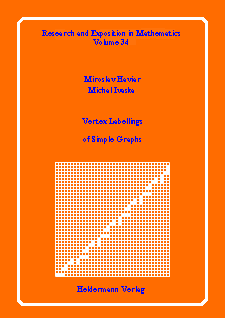Research and Exposition in Mathematics -- Volume 34
 Enlarged Picture
Enlarged Picture
Miroslav Haviar, Michal Ivaska
Vertex Labellings of Simple Graphs
ii+155 pages, soft cover, ISBN 978-3-88538-234-8, EUR 28.00, 2015
Graph theory belongs to the most dynamic disciplines within
present mathematics, and due to its beauty and wide
applications, also to the most popular areas of mathematics.
The area of graph labellings, on whose selected part this
monograph is focussing, is very young. Roughly speaking, a
graph labelling is an assignment of integers to the vertices
or edges, or both, of a graph, subject to certain
conditions. The bases of the theory of graph labellings were
laid out in the late 1960s, and since then a plethora of
graph labellings methods and techniques have been studied in
over 1900 research papers, monographs and theses.
One of the most famous open problems in graph theory
nowadays is the Graceful Tree Conjecture which says that
every tree can be gracefully labelled. A tree with m edges
has a graceful labelling if its vertices can be assigned the
labels 0,1,...,m such that the absolute values of the
differences in vertex labels between adjacent vertices form
the set {1,...,m}. The conjecture dates back to the
1960s and it is also known as the Ringel-Kotzig, Rosa or
Ringel-Kotzig-Rosa Conjecture. Only limited progress has
been made on the conjecture over the last fifty years despite
numerous research papers and various theses and surveys.
This monograph adds new results and new approaches to the
existing knowledge about vertex labellings of graphs.
We believe that it
brings advances in the study of vertex labellings of graphs
and that it will be of interest to researchers in this
area. We hope that the book will initiate further
development in the study of the newly introduced concepts
of Graph Chessboards and Labelling Relations as useful tools
to investigate vertex labellings of graphs and to tackle the
Graceful Tree Conjecture. We believe that especially the
visualization provided via the graph chessboards, and the
Graph Processor, developed and described in this book, could
make this topic more accessible to working mathematicians as
well as to students starting their
research work in this area.
List of Contents
 Enlarged Picture
Enlarged Picture
 Enlarged Picture
Enlarged Picture